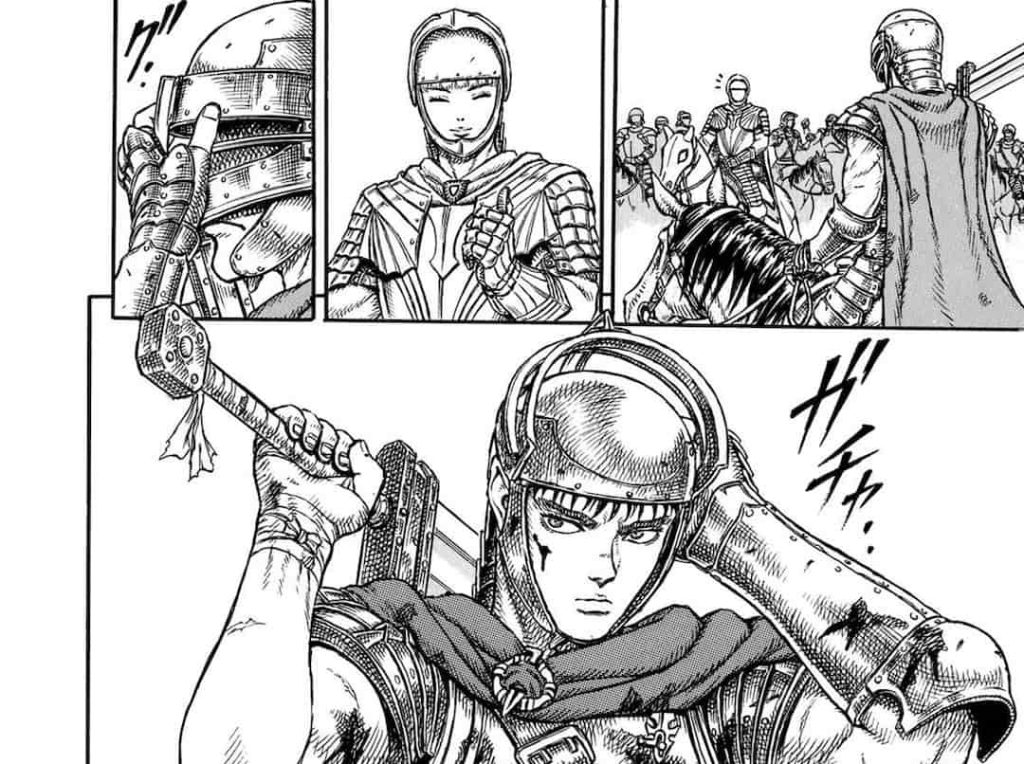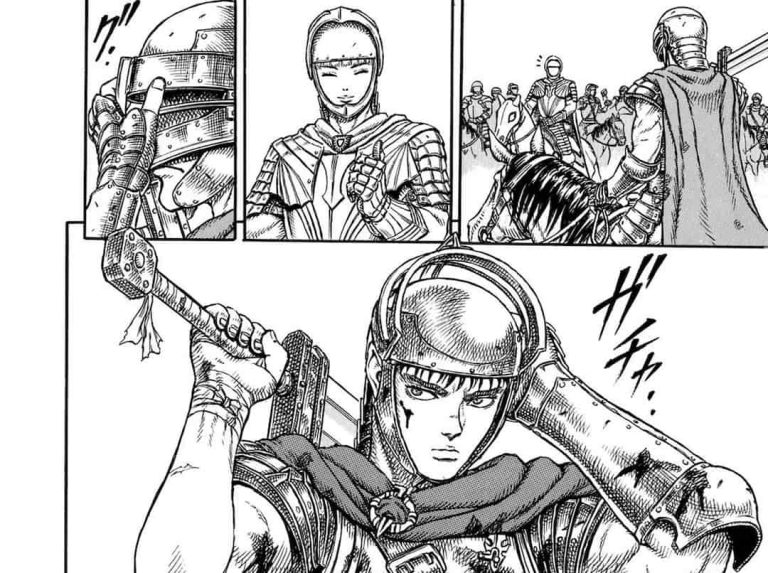The symbolism on the first page of Berserk: What every detail means
Kentaro Miura’s Berserk is a masterpiece that looks deeply into the complexities of human emotions, dark fantasy, and psychological horror. Right from the very first page of Berserk, readers are introduced to a visual narrative that sets the tone for the entire saga. It captures the entirety of the dark, gritty, and foreboding nature of the series, offering subtle hints about the themes that will evolve throughout the story.

This article examines the symbols, visual cues, and metaphors on the first page of Berserk, analyzing what each detail might signify and how it relates to the manga’s more significant themes.
Introduction to the first page of Berserk
The first page of Berserk is absolutely iconic. It’s super minimalistic but really powerful. It throws you right into a world of darkness, violence, and uncertainty. You’ve got Guts, the main guy, locked in this intense, aggressive pose with a demonic figure. The whole vibe is super unsettling, with these huge looming shadows, and it’s all just really grim.
At first, it might seem like a simple scene of a guy fighting a monster. But if you look closer, every little detail has a deeper meaning, hinting at the tough stuff Guts will go through in the series. Let’s break down the key parts of this first page and see what they tell us about the journey ahead.
Guts: An embodiment of human resilience
The first and most apparent figure on the first page of Berserk is obviously the main character, Guts himself. His aggressive posture, holding a massive weapon that seems too heavy for an ordinary man, immediately establishes him as a warrior, a man of sheer will and determination. However, there’s more to his character than just physical prowess.
Guts’s size is significant compared to the demonic figure in front of him. His imposing form, dwarfed by the shadowy figure, demonstrates a visual contrast that is symbolic of Guts’ ongoing battle against forces much larger and more powerful than himself.
Throughout Berserk, Guts faces literal demons, but this first page hints at the metaphoric demons that plague him as well: grief, betrayal, and rage. His constant fight against these overwhelming forces is a central theme in the story.
In addition, Guts’s solitary figure in this scene depicts his isolation. His life is one of loneliness, and even though he forms bonds throughout the series, he is often shown as a lone wolf, relying on no one but himself. The first page encapsulates this isolation, showing him locked in battle with no allies in sight.
The demonic figure: A symbol of fate and doom
The shadowy, demonic figure that looms over Guts in Berserk isn’t just any monster; it’s a symbol of the mighty evil at work in the world. This figure represents the demons Guts will face and the idea of fate and inevitability.
One of the main ideas in Berserk is the struggle between destiny and free will. Guts fights against a fate that seems unfairly forced upon him throughout his journey. The demonic figure can be seen as a representation of this fate, showing that his battle is not just physical but also against an unavoidable destiny.
This figure also hints at the enemies Guts will encounter, such as the Apostles and the God Hand, both of which play important roles in shaping his tragic life. The mysterious nature of the demonic figure symbolizes the uncertainty and unpredictability of the world he lives, where monstrous forces are always present.
The weapon: A metaphor for Guts’ burden
Guts’ weapon, shown as a massive sword, symbolizes the heavy burdens he carries. Akin to the struggles he faces, the sword is too large and complex to handle. Hence, its immense size represents the weight of his past, the trauma, battles, and both physical and emotional scars he carries with him.
As the series unfolds, the sword transforms into the Dragon Slayer, reflecting Guts’s destructive nature. It is also a reminder of his hardened character, shaped by a life of conflict and pain. The image of him wielding this massive sword on the first page of Berserk foreshadows the destruction and violence in the manga, as well as the toll it takes on Guts’ soul.
The darkness: A symbol of moral ambiguity
Darkness pervades the first page of Berserk. The shadows surrounding Guts and the demonic figure are more than just a visual cue for the genre of dark fantasy; instead, they pose a much deeper meaning and symbolize the moral ambiguity present in the world of Berserk.
Throughout the series, Guts operates in a morally gray area, hinting that he is neither a traditional hero nor a complete villain. He fights for survival, revenge, and, later, love and redemption, but his methods are often brutal and uncompromising.
The pervasive darkness on this first page foreshadows the morally complex choices Guts will make. His world is one where good and evil are not clearly defined, and the blurred lines between them are a recurring theme in the narrative. The use of shadows here also hints at the internal darkness Guts struggles with his inner rage, his trauma, and his thirst for vengeance.
The first page of Berserk and its more significant themes
When viewed in the context of the entire Berserk series, the first page of Berserk manifests the more significant themes that define the manga. It touches on fate, isolation, the struggle between good and evil, and the weight of trauma. Each visual cue, ranging from Guts’ stance to the looming demonic figure, serves as a metaphor for the existential and emotional battles Guts will face.
Moreover, the stark contrast between light and dark on the first page reflects Berserk’s overarching tone. In this world, moments of light (friendship, love, and hope) are often overshadowed by the ever-present darkness (betrayal, loss, and despair). The series, much like its protagonist, constantly wrestles with these dualities.
To sum up
The first page of Berserk is more than meets the eye. It’s not just an introduction but a visual thesis statement for the entire series. By finding deeper meaning in its symbols, readers can truly appreciate the depth of the epic story and the journey that lies ahead. This iconic page sets the stage for the dark, philosophical, and violent themes that will unfold, leaving a lasting impact as the plot develops.






